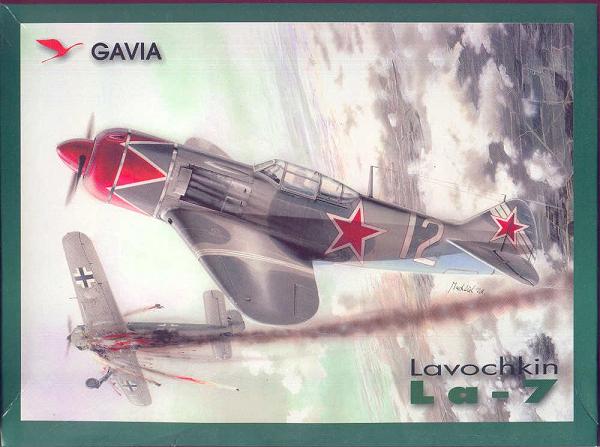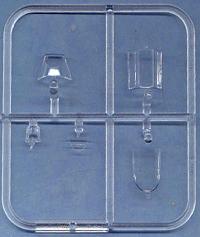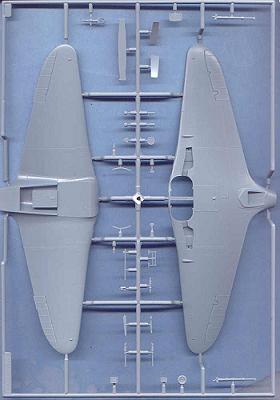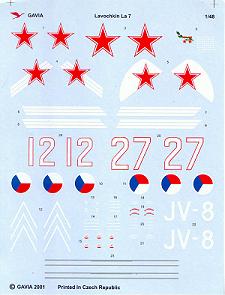
|
KIT: |
Gavia 1/48 La-7 |
|
KIT # |
|
|
PRICE: |
$34.95 MSRP |
|
DECALS: |
Three aircraft |
|
REVIEWER: |
|
|
NOTES: |

|
HISTORY |
The Lavochkin La-7 was the ultimate wartime design of a line of fighters that began with the LaGG-3 in 1941. The LaGG-3 suffered from a heavy structure due to its designers unfamiliarity with modern aircraft design and the fact that the state of the Soviet aircraft industry forced them to use wood throughout instead of the lighter aluminum structures being developed in the west, and the lack of a engine of suitable power other than the M-105 1,000 h.p. license-built derivative of the Hispano-Suiza 12-Y series. The LaGG-3 was forced into service due to a lack of alternative, and gained the nickname among its pilots of "varnished guaranteed coffin."
The design team was not unaware of the problems of the LaGG-3. The appearance of the Fw-190 on the Eastern Front was enough for them to obtain official permission to explore the possibility of developing a radial-engined fighter, the result of which was the La-5 series which appeared in 1943, with 150% more power than the LaGG-3 and a worthwhile armament of two 20mm cannon. The ultimate development of this series - the La-5FN - was the first Soviet fighter that could really hold its own against the Fw-190 in combat and was superior to the Bf-109G at low altitude, and was widely produced.
While the La-5 could at least confer equality on Soviet pilots, the designers wanted superiority. A more powerful Shvetsov radial was developed, but it was unreliable; there would be no possibility of increasing engine power past the 1,850 h.p. of the ASh-82FN engine used in the La-5FN. Thus, the designers engaged in a program to further lighten the airframe by the substitution of aluminum structures for the main spar and other parts of the design wherever possible, as well as a general cleaning-up of the airframe.
The result was the La-7, which first appeared in prototype form in January, 1944. With the airframe gaps sealed, a different propeller, and the engine oil cooler removed from the drag-producing position atop the engine cowling to a neat scoop under the fuselage, the wheel wells covered completely, and a different exhaust cover, maximum speed was increased to 407 m.p.h at 15,000 ft. - over 40 m.p.h. faster than the La-5FN - making the La-7 the fastest of all Soviet fighters to see service during the war. Interestingly, the control stick changed from the spade grip of the La-5 to an American-style stick almost exactly the same as the P-39 Airacobra. It had been originally planned to arm the La-7 with three Berezin B-20 lightweight 20-mm cannon; however, delivery delays required that the majority of the La-7s that saw combat were armed with the two ShVAK 20mm cannon used by the La-5; only 368 3-cannon La-7s were delivered to combat units before the end of the war, compared with more than 3,000 of the 2-cannon variety.
In combat, the standard La-7 was 44 mph faster than the Fw-190 at sea level, was 22 mph faster than the Butcher-bird at 20,000 feet, and outclimbed it at all altitudes below 20,000 ft. The La-7 was more than 2,000 pounds lighter than its German opponent, which translated into maneuverability the Focke-Wulf could not match in close maneuvering combat at any altitude.
The first La-7s to reach an operational unit were delivered in July 1944, to the 176th Guards Fighter Aviation Regiment, of which Ivan Kozhedub - the leading V-VS ace - was deputy commander. Kozhedub would score 17 of his 62 kills in the La-7, including a Me-262 shot down on February 15, 1945.
Between September 15 and October 15, 1944, the 63rd Guards Fighter Aviation Regiment scored 55 victories - 52 Fw-190s and 3 Bf-109Gs - for the loss of only seven La-7s. The new Lavochkin fighter was clearly a winner where it mattered.
The La-7 rapidly disappeared from V-VS service after the war. The aircraft had been developed under the assumption that its combat life would be less than the airframe life; the airframe life was calculated as three years if hangared at all times. The La-7 was completely gone from Soviet service by 1947.
|
THE KIT |
 |
  |
 Gavia - a
company that contracts with Eduard for production of their kits - can no longer
be called a "limited-run" kit manufacturer. Utilization of the Eduard
facilities means that production quality is in the same league with anything
coming from Hasegawa or Tamiya. With the arrival of this kit of the La-7, the
company has now demonstrated that their production design is the equal of
Tamiya's, since this well-designed kit is an obvious "fall-together slammer."
Gavia - a
company that contracts with Eduard for production of their kits - can no longer
be called a "limited-run" kit manufacturer. Utilization of the Eduard
facilities means that production quality is in the same league with anything
coming from Hasegawa or Tamiya. With the arrival of this kit of the La-7, the
company has now demonstrated that their production design is the equal of
Tamiya's, since this well-designed kit is an obvious "fall-together slammer."
Gavia's kits have improved with each release starting with their Po-2 in 2000; while each was quite acceptable, each succeeding kit is better than the last. On this La-7, the trailing edges of all flying surfaces are exceptionally thin, and the surface detail is crisp and realistic-looking.
Some modelers have complained that the cockpit appears "simplified." In fact, the cockpits of the Lavochkin series were all Spartan by any standards. With only a bit of effort for such things as creating throttle levers and adding in a seat belt, the cockpit of this kit will result in a very acceptable-looking model. The three-pat canopy is a bit thick, resulting in an overly-narrow rear section in order to display the canopy in the open position, but doing so will result in an acceptable "look" when completed. Those modelers who are concerned with this could obtain the Squadron (Falcon) La-5 canopy, since that design was used for both the La-5 and La-7.
Decals are included for the La-7 flown by Ivan Kozhedub, as well as an La-7 flown by Maj. F.N. Kosapalov and one used post-war by the Czech air force.
|
CONCLUSIONS |
This is a well-designed kit of an important aircraft of the Second World War that will make up into a very good-looking model.
Thanks to Gavia for the review kit.
If you would like your product reviewed fairly and quickly where it will be seen by well over 150,000 visitors a month, please contact me or see other details in the Note to Contributors.